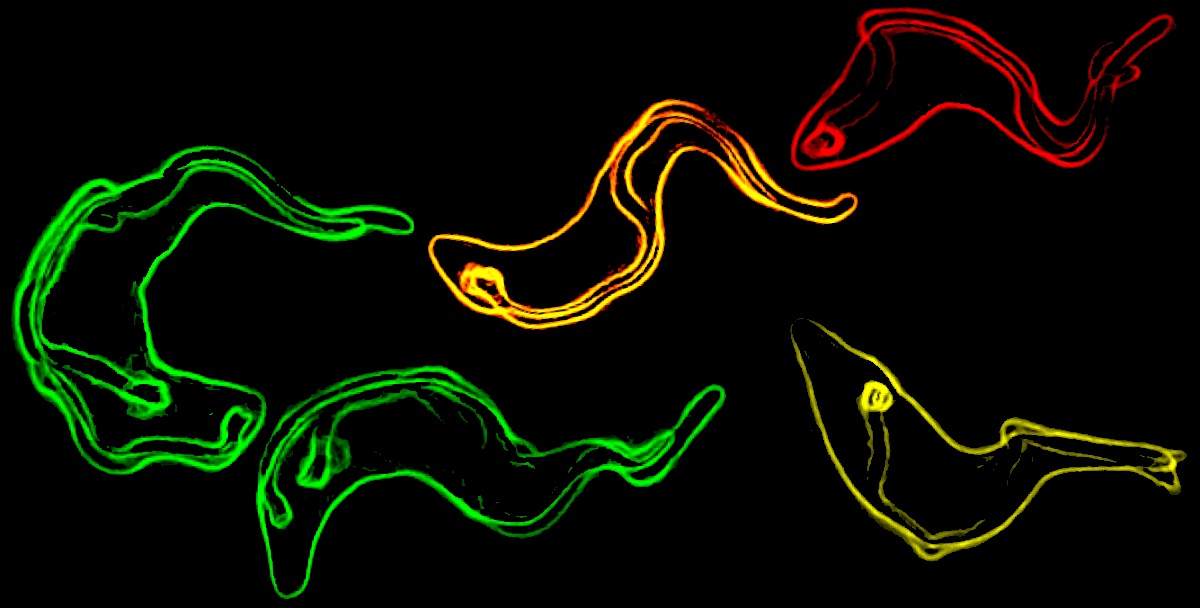How trypanosomes sidestep immunity
Interview with
Trypanosomes, the organisms that cause sleeping sickness, are extremely difficult to eliminate from the body partly because the organisms frequently shuffle the antigens that they express on their surfaces, so they present a moving target to the immune system. How this antigen shuffling trigger is achieved though is a mystery. The University of Wurzburg's Christopher Batram has found that when the bugs activate a new antigen, they use an epigenetic system to shutoff the expression of the old one.  He explained this to Chris Smith...
He explained this to Chris Smith...
Christopher - African trypanosomes which cause the sleeping sickness in humans evade the host's immune system by expressing markers on the said surface that are recognised by the immune system. They have a huge family of this marker genes in the genome, but only one is expressed at any given time. Nothing is known about the mechanism of how this is achieved, how just one marker is expressed at any given time and the other ones remain silent.
Chris - Do the parasites, the trypanosomes change those markers at various points in order to make themselves look different, give themselves a chemical facelift if you like, so the immune system finds it hard to recognise them?
Christopher - Yes, they periodically switch the expression from one marker to another. It's not known how they do these switches. So, the problem you've got is, how do we turn off a very big group of genes? Leave just one active, but then periodically, totally mix things up and select a gene from the inactive group and suppress the one that was turned on.
Christopher - Exactly. The question was, how do trypanosomes activate a new antigen and how they de-activate the previously active one? One possibility is that the active one could first be silenced before a new one is activated. There's a little problem with that because silencing the active gene by RNAi causes a cell cycle arrest the cells eventually die. So, we hypothesise that this could be the other way around. A previously silent gene is randomly activated and thus, this is causing the deactivation of the active one.
Chris - I see. So, a new one switches on and it's the process of switching on the new one that in some way, turns off the existing one. In this way, you've always got a surface marker gene active, so you won't go into cell cycle arrest, but you don't turn off the existing one until you've got a new one ready to go.
Christopher - Exactly.
Chris - What experiments did you do to then workout whether that was the case? Did you put some kind of marker into one of the genes and then turn it on with another to see if that marker does what you would predict it would?
Christopher - Yes. So, we introduced a second surface marker gene into a different genomic context which we can inducibly express by adding a chemical.
Chris - And when you turn on that second gene, does the first gene switch off as you would predict it would?
Christopher - Yes, it does.
Chris - How did you then unpick that? So, do you know what the new gene coming on is doing to the transcriptional system for the first marker gene to make it shut down? How's that being achieved?
Christopher - So, this remains unknown. We know that it depends on histone modifications.
Chris - So, that's interesting. So, rather than it, directly shutting off promoters or something, it's doing it via a modification of the histone. It's doing it epigenetically.
Christopher - Yes, exactly. That is the case. We did the same experiments with the knockout cell line in which histone methyltransferase was deleted. When you over expressed the second gene of these cells then the endogenous gene was silenced, but not the whole transcription unit.
Chris - So, you over expressed just the surface antigen gene for the second surface marker and this had this shutting down effect. So, there must be something intrinsic to that antigenic signal which is activating this epigenetic modification apparatus.
Christopher - Yes.
Chris - How is it doing that?
Christopher - We don't know. That's the big question we are challenged with now.
Chris - Would you like to speculate because you must have some theories as to how it's doing this? What do you think is going on?
Christopher - It could be that the initial spike of the production of two surface antigens could relay a signal to the silence machinery in order to maintain this monolithic expression. So, one possibility is that there's a signal coming from the endoplasmic reticulum, folding proteins so-called chaperon or something like that, but we have actually no idea.
Chris - This could be very important, this mechanism because one of the big problems with sleeping sickness, trypanosomiasis, is that it's very hard to rid the body of these bugs, the immune system can't get a handle on them because they evade immunity. So, if we can find a way to clog up their system and stop them shapeshifting themselves in this way, maybe the immune system would gain the upper hand and eliminate them.
Christopher - Exactly. This is the future goal - to get more insights into this mechanism, how the transcription unit is silenced. When we can trigger this chemically, then we can get rid of the parasites, maybe.
- Previous Finding a missing link
- Next Eczema prevents skin cancer










Comments
Add a comment